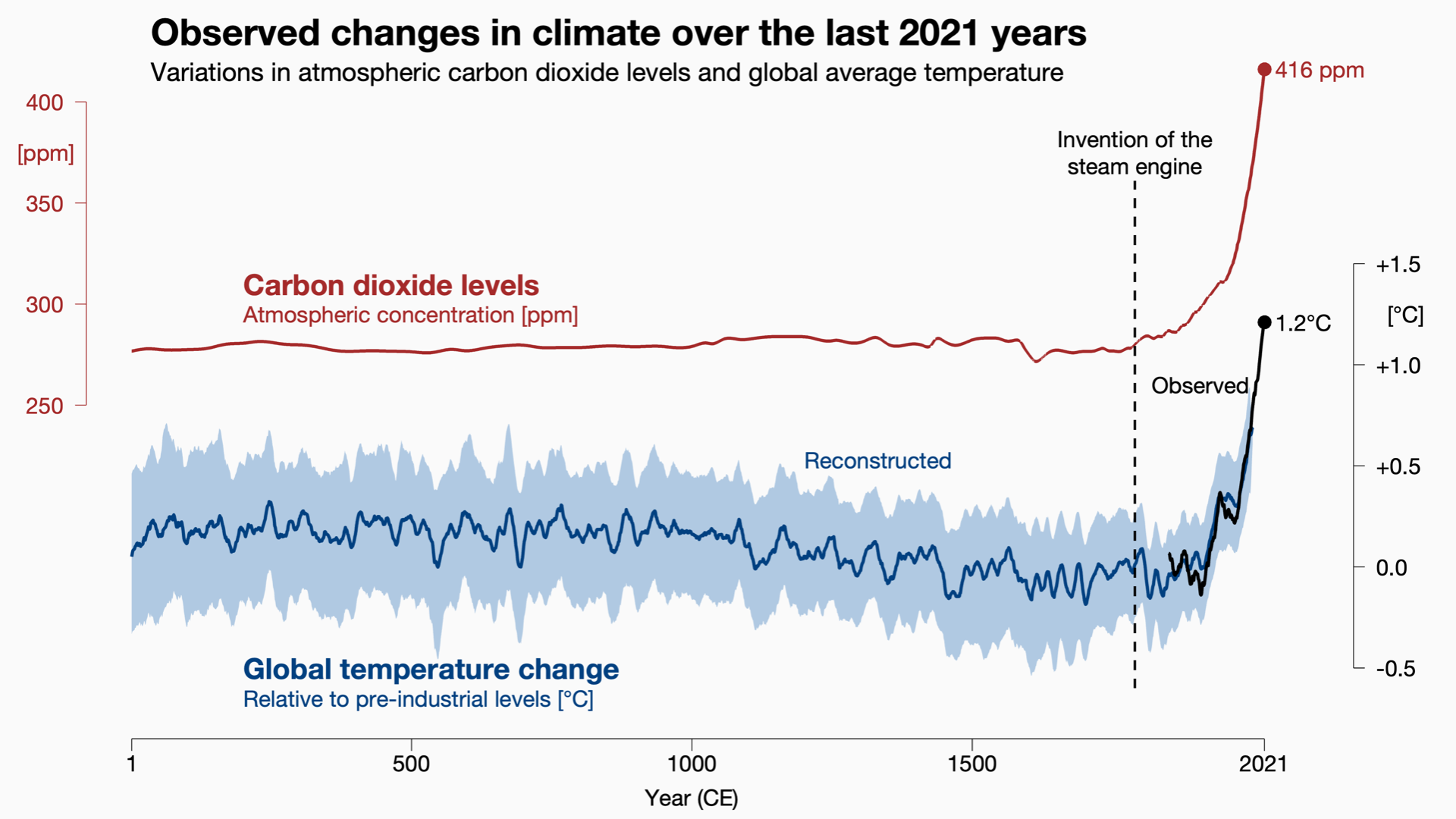This blog post is a short summary of key points that are of current relevance to society from the physical science of climate change. It is based on the headline statements of a report published in 2021 by the Intergovernmental Panel on Climate Change (IPCC). The IPCC is a United Nations body responsible for providing impartial assessments of climate science. Its reports inform international negotiations on tackling climate change.
Written by Jonathan Gregory, Matt Palmer and Ed Hawkins
How and why has the climate changed?
Widespread and rapid changes have taken place in the atmosphere, in the ocean and on land. There is no doubt that the climate has warmed because human activities have increased the amounts of greenhouse gases in the atmosphere, especially carbon dioxide (CO2) and methane (CH4).
Greenhouse gases warm the climate by making it harder for the atmosphere to radiate heat into the surrounding universe (space). They insulate the atmosphere against losing heat, rather like making it warmer inside a house by insulating the roof. The physics of this greenhouse effect has been understood for more than a century.
The largest human-caused effect on climate is due to the build-up of CO2, mostly from burning fossil fuels (coal, oil and gas). The size and speed of recent changes in many aspects of the climate system exceed any seen for hundreds or thousands of years (Figure 1).

The warming causes changes in many other aspects of climate. For example, many extreme weather and climate events in every region across the globe have already become more severe or more frequent due to human-caused climate change (Figure 2).

What climate change will happen in future?
Improved scientific knowledge has narrowed the range of warming expected as a result of increasing the amount of CO2 in the atmosphere.
Global-average surface temperature will continue to get warmer until at least the 2050s. Before 2100 it will be over 2°C warmer than it was before the industrial revolution, unless human-caused emissions of CO2 and other greenhouse gases into the atmosphere are greatly reduced in the coming decades.
Many aspects of climate change will grow larger as global-average temperature becomes warmer. Heatwaves, heavy rainfall and droughts will become more severe or more frequent (Figure 2). Arctic sea ice, snow cover and permafrost will decrease.
Rainfall over land will become more variable as global-average surface temperature becomes warmer. Wet and dry episodes will both become more severe. Rainfall will increase on average in monsoons and at high latitudes, but decrease in some regions at low latitudes.
If CO2 emissions increase, a larger proportion of the extra CO2 will remain in the atmosphere. This is because the proportion absorbed by the ocean, plants and soil will decline.
It would take hundreds to thousands of years to reverse many of the changes due to past and future greenhouse gas emissions. This especially applies to changes in the ocean, sea level and the ice sheets of Greenland and Antarctica. For some changes, there could be “no going back” in practice, because they would take far longer to reverse than the timescales relevant to society.
Information relevant to assessing the risks from climate change and adapting to its effects
Normal variations in climate between years and decades will continue on top of human-caused climate change. These variations are important to consider in planning for the full range of possible changes, especially on regional scales in the near future. However, they have little effect on long-term trends.
Every region will experience impactful changes in climate and weather as global-average surface temperature gets warmer, such as more frequent or severe extreme events. These effects will be worse because impactful events of more than one type will occur together increasingly often. The greater the warming, the greater and more widespread the changes.
In assessing the risks of climate change, it is important to consider some even larger changes which we cannot rule out. These include collapse of ice sheets, abrupt changes in ocean currents, combinations of extreme events, and very large increases in global-average surface temperature.
Information relevant to limiting future climate change
To limit human-caused global warming, net CO2 emissions must be reduced to zero or below. Large reductions in emissions of other greenhouse gases are required as well. “Net zero emissions” of CO2 over a given period means that the amount of CO2 removed from the atmosphere during the period is equal to the amount added to the atmosphere during the period. Net negative emissions means that more is removed than added, so the amount in the atmosphere goes down.
After large reductions in emissions of greenhouse gases, air pollution would reduce and air quality would improve within a few years. We would also see differences in trends of global-average surface warming after about 20 years. It would take longer for differences to become apparent in other impactful aspects of climate change.
Ed, will you be updating the CMIP5 vs. observations graph this spring?